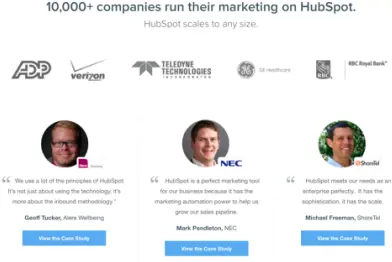How HubSpot Personalizes Every Customer Touchpoint
At HubSpot, optimization is something we focus on every single day. It helps us deliver more engaging experiences to our customers and see greater returns on the content we push across our marketing channels. We test and personalize just about everything. Here are a few examples of experiments we’ve run that have measurably improved our marketing programs.

Amanda Sibley

 At HubSpot, optimization is something we focus on every single day. It helps us deliver more engaging experiences to our customers and see greater returns on the content we push across our marketing channels.
At HubSpot, optimization is something we focus on every single day. It helps us deliver more engaging experiences to our customers and see greater returns on the content we push across our marketing channels.
What has made our optimization strategy most effective is thinking about testing as an overarching strategy, not just a task on our to-do list. We test across all of our marketing channels — email, website, social, blog — you name it, we test it.
We also try to connect the dots from our learnings and experiments as much as possible. Rather than running one test on our homepage and calling it a day, we apply those learnings across our other marketing channels. That one homepage test may eventually result in a series of follow-up experiments across our landing pages, email marketing, and more. This has helped us build a hyper-effective testing strategy and see huge wins.
We test and personalize just about everything. Here are a few examples of experiments we’ve run that have measurably improved our marketing programs.
Personalized Homepage
Tailoring the content and materials on your website to the audience browsing them can have a huge impact. Depend on company-size, for example, we’ll serve up specific case studies and value props geared towards your business. We recently ran a test that experimented with tailored messaging for enterprise companies.
The original, default feature on our homepage showed three different case studies, from three different sized companies.
We tested personalizing the experience for enterprise companies. If we identified a site visitor as being from an enterprise-sized company, they saw logos and case studies from similar, large companies.
By personalizing in this way, we were able to the visitor that our software is a good fit for their company. This tactic has helped us achieve a 42% improvement in clicks on our calls-to-action.
Personalized Landing Pages
Another place where personalization comes into play is on our site’s landing pages. Depending on a person’s lifecycle stage (visitor, lead, customer), they will see slightly different content on a HubSpot landing page.
Both the title and the form are customized depending on the viewer. On the post-download page, the personal experience is taken one step further, and the “downloaders” name is actually addressed:
Email Experimentation
Email marketing is one of the most direct ways to reach your audience, but can also be the biggest turn-off for customers (spam alert!). That’s why we test all the emails we send.
In a recent series of tests, we experimented by removing the images from some of our email campaigns.
Contrary to what you might think, we found that removing images from our marketing emails actually increased click-throughs by 60%. We’ve since optimized our customer emails accordingly–removing images and focusing on the text our audience prefers.
Other email tests we’ve run have focused on subject line, length, copy positioning, signature/from address, and calls-to-action.
Social Media Optimization
Based on our findings from the email-image tests, we decided to test the use of images in our tweets as well. This time around, we all believed the image would perform better–it looks more appealing and owns more real estate. Did our Twitter followers agree? Yes!
The tweet with the image saw 36% more clicks, 41% more retweets, 48% more favorites, and 55% more leads generated.
Blog Call-To-Action Tests
Our blog has millions of viewers each month and is one of the better lead generation channels for our marketing team.
We recently tested two different types of CTAs to see what resonated best with our audience–our original CTA, located at the bottom of each blog post, versus a slide-in CTA located closer to the top of the page. We wanted to understand if a CTA that was “more disruptive” would attract more clicks and convert more leads than the typical bottom-of-the-page button.
Site visitors responded significantly better to the “more disruptive” variation — a 106% increase in click-throughs and a 38% increase in leads generated. To better serve our visitors (and increase conversions) going forward, we implemented slide-in CTAs on most of our top-performing blog posts.
Now, It’s Your Turn
As you can see, there are numerous places across your marketing channels that can be optimized for more success. Luckily, some of these adjustments can be done quickly and you can start seeing a difference right away!
If you’d like to learn more about optimization, personalization, and high-impact areas to test on your site, join HubSpot and Optimizely for a live webinar: Optimize Your Online Marketing Channels. Experts from both companies will walk through optimization tips and ideas, and more examples of tests you can run right away to drive impact for your business.







